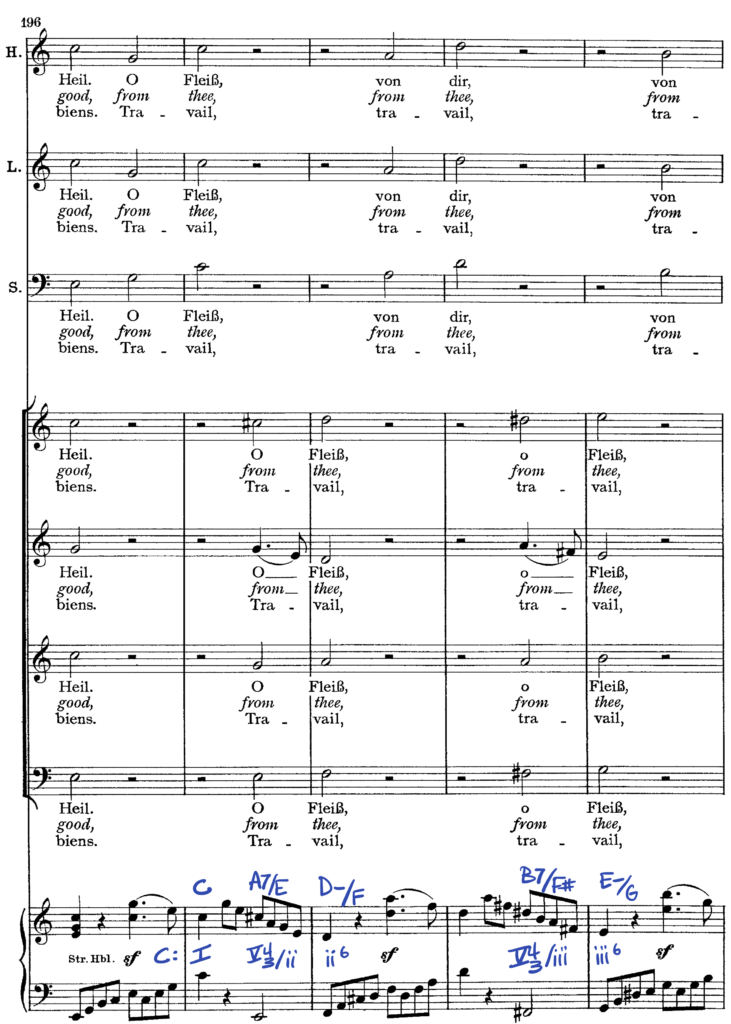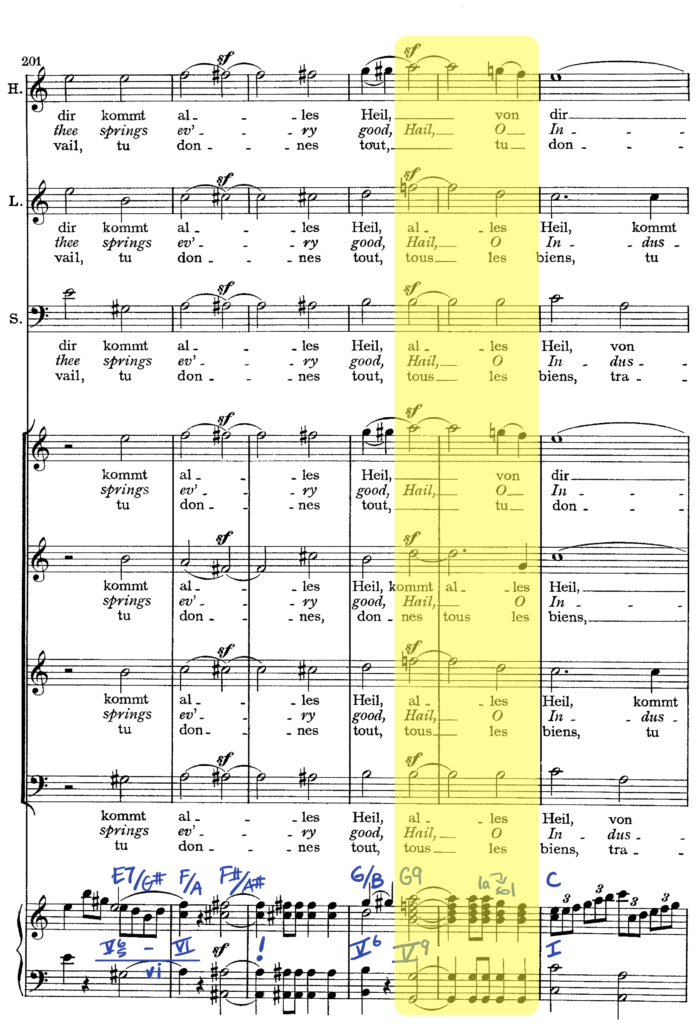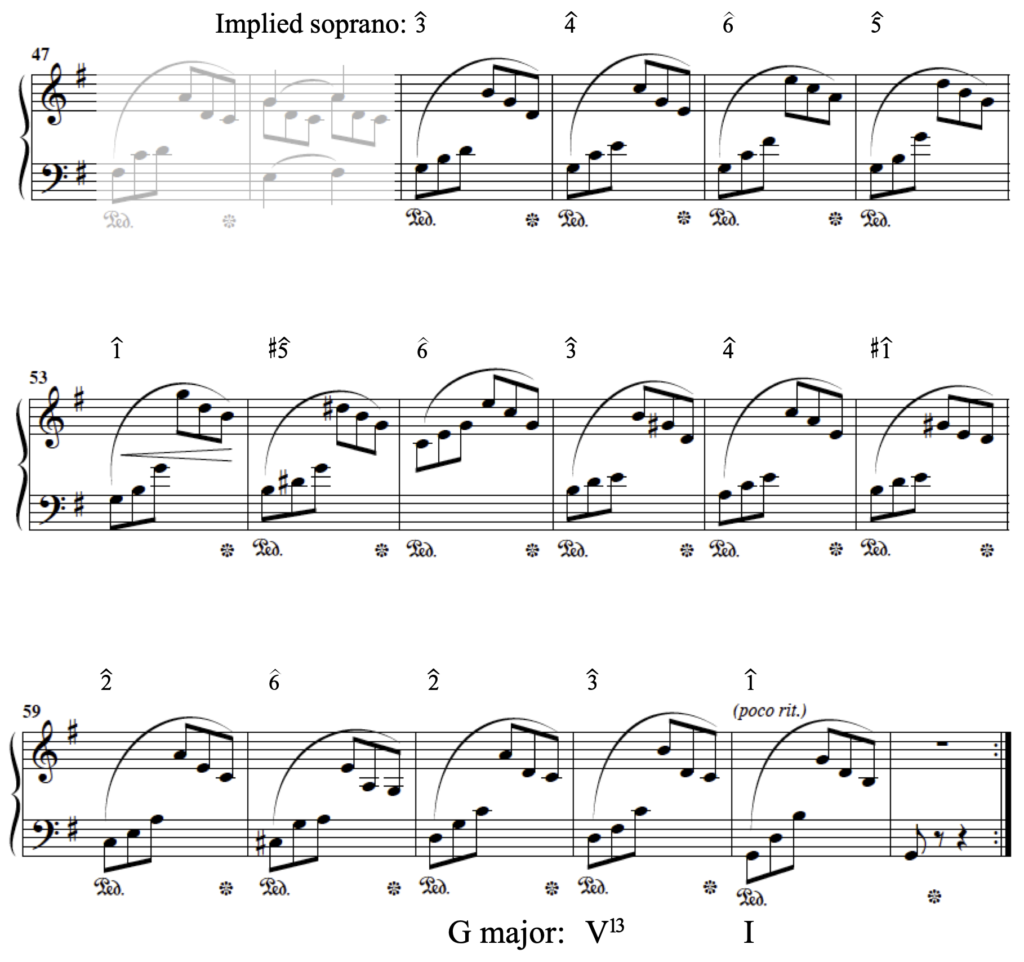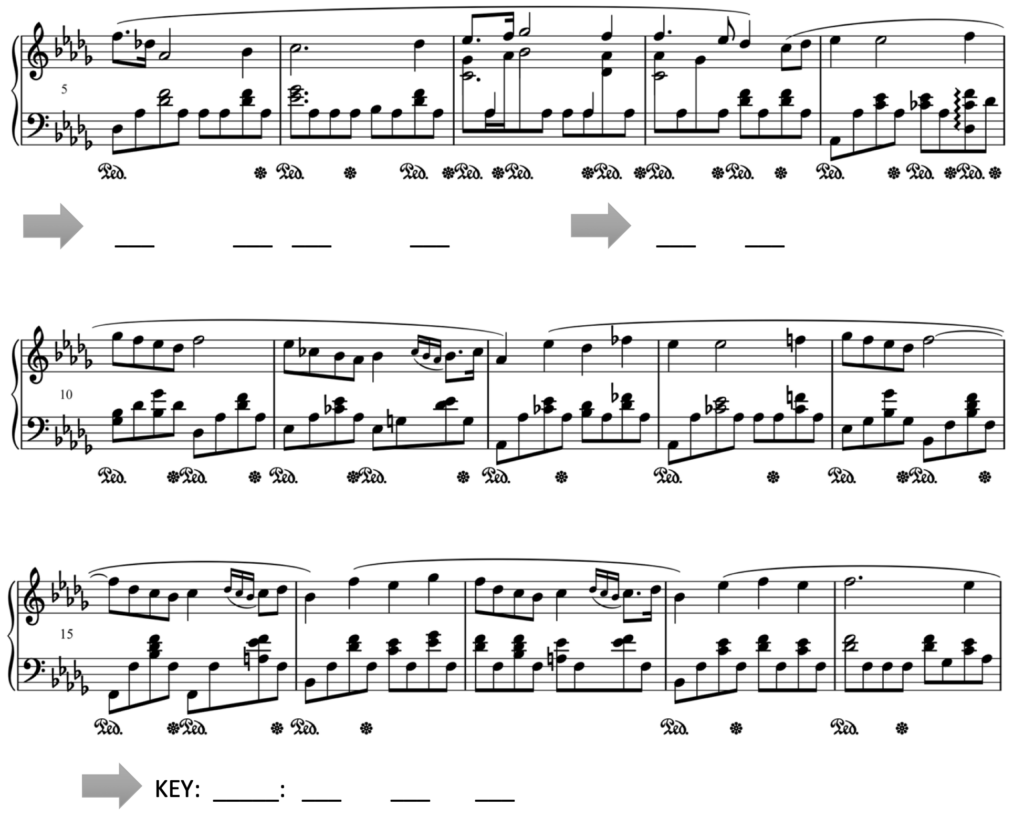Main Body
47 Extended tertian chords and altered dominants
Learning goals for Chapter 47
In this chapter, we will learn:
- How to spell and identify (ninths, elevenths, and thirteenths)
- How to spell and identify
- How these chords function in musical contexts
are chords built in thirds that go beyond seventh chords, constructed by placing additional thirds above the seventh. Adding thirds to a seventh chord does not change the chord’s function. Instead, the extended tertian chords create a different “color” or “sound” for the same function.
For instance, the extended tertian sonorities V9, V![]() 9, V11, V13, and V
9, V11, V13, and V![]() 13 all have dominant function, just like the V7 chord.. All of these chords are possible in the major mode; however, only V
13 all have dominant function, just like the V7 chord.. All of these chords are possible in the major mode; however, only V![]() 9 and V
9 and V![]() 13 occur in the minor mode and may also appear as borrowed chords in major keys.
13 occur in the minor mode and may also appear as borrowed chords in major keys.
The ii9 chord functions predominantly, like the ii and ii7. It is found only in major keys, often preceding the V13 chord.
Overview of how to spell extended tertian chords
When writing in four voices () with extended tertian chords, place the most extended note (e.g., the ninth, eleventh, or thirteenth) in the soprano voice. Since extended tertian chords involve more than four notes, some members must be omitted in a four-voice texture:
- Ninth chords: omit the fifth [rendering Root – 3rd – 7th – 9th]
- Eleventh chords: omit the third and the fifth [rendering Root – 7th – 9th – 11th]
- Thirteenth chords: omit the fifth, ninth and eleventh [rendering Root – 3rd – 7th – 13th]
Finally, extended tertian chords will typically appear in root position. Avoid using inversions with extended tertian chords.
Video: T90 Extended tertian chords video 1: intro (3:52)
This video gives a general definition of extended tertian chords and explains their basic features.
Dominant ninths and thirteenths
Study the following examples, which show how to resolve and voice each type of extended tertian chord. For ninth and thirteenth chords, it is customary to use the root, third, seventh, and most extended note (the ninth or thirteenth above the root, respectively). Example 47-1 shows the V9. As with all ninth chords, we spell the V9 with root, third, seventh, and ninth when writing in four voices.
Example 47-2 features an exciting V9 near the end of the second movement of Haydn’s Herbst (Autumn) from Die Jahrzeiten (The Seasons) in vocal score (orchestral reduction) format. The chord is highlighted in the example, and annotations showing lead sheet symbols and corresponding Roman numerals are provided. Video T91 explores this passage using the full orchestral score in the analysis.
Example 47‑2. Franz Joseph Haydn, Die Jahrzeiten, Herbst, mvt. 2, “Son lohnet die Natur den Fleiss,” mm. 196–206
Listen to the full track, performed by soprano Angela Maria Blasi, tenor Josef Protschka, bass Robert Holl, the Arnold Schoenberg Chor, and the Vienna Philharmonic conducted by Nikolaus Harnoncourt, on YouTube.
Read an English translation of the song text on lieder.net.
Learn about Austrian composer Franz Joseph Haydn (1732–1809) by reading this Oxford Music Online article, written by Georg Feder and James Webster.
Video: T91 Extended tertian chords video 2: V9 (3:33)
This video explores the V9 chord, its spelling and use in major keys, and its appearance at the end of the second movement of Haydn’s Herbst (Autumn) from Die Jahreszeiten (The Seasons), Example 47‑2.
The V![]() 9 features the same voice leading and chord members (root, third, seventh, ninth) as the V9, as shown in Example 47-3. The only difference between the V9 and V
9 features the same voice leading and chord members (root, third, seventh, ninth) as the V9, as shown in Example 47-3. The only difference between the V9 and V![]() 9 is is whether the ninth above the root is major or minor.
9 is is whether the ninth above the root is major or minor.
Example 47-4 shows the V![]() 9 used three times in the first phrase of “Close Every Door” from Joseph and the Amazing Technicolor Dreamcoat. This example is in F minor, and the V
9 used three times in the first phrase of “Close Every Door” from Joseph and the Amazing Technicolor Dreamcoat. This example is in F minor, and the V![]() 9 is spelled C – E
9 is spelled C – E![]() – B
– B![]() – D
– D![]() in four voices. Video T92 walks you through Examples 47-3 and 47-4.
in four voices. Video T92 walks you through Examples 47-3 and 47-4.
Example 47‑4. Annotated transcription of Andrew Lloyd Webber and Tim Rice, “Close Every Door” from Joseph and the Amazing Technicolor Dreamcoat (original Broadway cast recording), 0:08–0:22
Listen to the full track on Spotify.
Learn about English composer Andrew Lloyd Webber (b. 1948) by reading this Oxford Music Online article, written by John Snelson.
Video: T92 Extended tertian chords video 3: V![]() 9 (2:37)
9 (2:37)
This video explores the V![]() 9, its spelling and use in major keys (borrowed) and minor keys (diatonic), and its use in Andrew Lloyd Webber’s “Close Every Door” from Joseph and the Amazing Technicolor Dreamcoat (Example 47‑4).
9, its spelling and use in major keys (borrowed) and minor keys (diatonic), and its use in Andrew Lloyd Webber’s “Close Every Door” from Joseph and the Amazing Technicolor Dreamcoat (Example 47‑4).
The V13, shown in Example 47-5, features the root, third, seventh, and thirteenth, and the soprano typically resolves down from scale degree ![]() (the chordal thirteenth) to tonic (the root of the tonic triad). Often composers will connect these notes by step, passing through scale degree
(the chordal thirteenth) to tonic (the root of the tonic triad). Often composers will connect these notes by step, passing through scale degree ![]() .
.
Example 47-6 features a V13 chord in the key of G major near the end of the excerpt. Video T93 walks you through Examples 47-5 and 47-6, which explore the V13.
Example 47‑6. Robert Schumann, “Kleine Studie,” from The Album for the Young, no. 14, mm. 47–64
Listen to a recording of this piece, performed by Vladimir Feltsman, in its entirety on Spotify.
Learn about German composer Robert Schumann (1810–1856) by reading this Oxford Music Online article, written by John Daverio and Eric Sams.
Video: T93 Extended tertian chords video 4: V13 (3:29)
This video examines the V13 chord, its spelling and use in major keys, and its appearance at the end of Robert Schumann’s “Kleine Studie” from his Album for the Young (Example 47‑6).
The V![]() 13 works just like the V13. The only difference in spelling these chords involves the thirteenth above the root: major (MA13) in the V13 and minor (mi13) in the V
13 works just like the V13. The only difference in spelling these chords involves the thirteenth above the root: major (MA13) in the V13 and minor (mi13) in the V![]() 13.
13.
Example 47-8 features many chromatic chords, including an and a , in addition to the V![]() 13 in the second-to-last measure. This passage is in the key of C minor, and in this key, the V
13 in the second-to-last measure. This passage is in the key of C minor, and in this key, the V![]() 13 is spelled G – B
13 is spelled G – B![]() – F – E
– F – E![]() . Notice the E
. Notice the E![]() is featured in the melody and moves through D (scale degree
is featured in the melody and moves through D (scale degree ![]() ) before resolving to C (tonic). Video T94 explores the V
) before resolving to C (tonic). Video T94 explores the V![]() 13 and its use in Example 47-8.
13 and its use in Example 47-8.
Example 47‑8. Frederic Chopin, op. 28, no. 20, Prelude in C minor, mm. 9–13
Listen to a recording of this piece, performed by Alexandre Tharaud, in its entirety on Spotify.
Learn about Polish composer Frederic Chopin (1810–1841) by reading this Oxford Music Online article, written by Jim Samson.
Video: T94 Extended tertian chords video 5: V![]() 13 (3:32)
13 (3:32)
This video explores the V![]() 13, its spelling and resolution, and its use in Chopin’s Prelude, op. 28, no. 20 (Example 47‑8).
13, its spelling and resolution, and its use in Chopin’s Prelude, op. 28, no. 20 (Example 47‑8).
EXERCISE 47-1 Spelling dominant ninths and thirteenths
For each of the following, provide a key signature and realize the chord in four voices on the staff. All chords should be in root position, and the most extended note should be placed in the top voice.
Remember, in minor keys, V![]() 9 and V
9 and V![]() 13 chords require a raised leading tone, but the most extended note is already lowered. And in major keys, the V
13 chords require a raised leading tone, but the most extended note is already lowered. And in major keys, the V![]() 9 and V
9 and V![]() 13 require lowering the most extended note, but the leading tone is already raised.
13 require lowering the most extended note, but the leading tone is already raised.
SET 1
SET 2
Dominant eleventh and supertonic ninth
In contrast to ninth and thirteenth chords, eleventh chords omit the third and fifth in four-part textures, using the root, seventh, ninth, and eleventh. Another way of thinking about spelling the V11 is to use scale degree ![]() in the bass, with the notes from the subdominant triad above it (scale degrees
in the bass, with the notes from the subdominant triad above it (scale degrees ![]() ,
, ![]() , and
, and ![]() ). Example 47-9 shows the spelling and resolution of the V11 in F major. Video T95 walks you through this example and Example 47-10.
). Example 47-9 shows the spelling and resolution of the V11 in F major. Video T95 walks you through this example and Example 47-10.
Spell the V11 and its resolution in A![]() major, and listen for this progression near the end of the chorus section in Example 47‑10. Select the right arrow over the image below to view the answer.
major, and listen for this progression near the end of the chorus section in Example 47‑10. Select the right arrow over the image below to view the answer.
Example 47‑10. Carole King, “You’ve Got a Friend,” 1:20–1:47
Listen to the full track on Spotify.
Learn about American songwriter Carole King (b. 1942) by reading this Oxford Music Online article, written by Richard D. Driver.
Video: T95 Extended tertian chords video 6: V11 (4:22)
Learn about the V11 chord by watching this video, which explores the spelling and resolution of the V11 chord, its hybrid properties (combining scale degree ![]() and the notes from the IV chord), and its use in Carole King’s “You’ve Got a Friend” (Example 47‑10).
and the notes from the IV chord), and its use in Carole King’s “You’ve Got a Friend” (Example 47‑10).
Like the other ninth chords we have studied, the supertonic ninth chord (ii9) uses the root, third, seventh, and ninth in four-part textures. It often connects to a V13, as the soprano note (scale degree ![]() , or “mi”) is the same in both the ii9 and V13. Example 47-11 shows the spelling and resolution of the ii9 in the key of F major. Video T96 explores Example 47-11 and how the ii9 works in a repeating progression in Example 47-12.
, or “mi”) is the same in both the ii9 and V13. Example 47-11 shows the spelling and resolution of the ii9 in the key of F major. Video T96 explores Example 47-11 and how the ii9 works in a repeating progression in Example 47-12.
Realize the ii9 – V13 – IMA7 progression in C major, which is featured in Example 47-12. Select the right arrow over the image below to view the answer.
Example 47‑12. Maroon 5, “Sunday Morning,” 0:00–0:27
Video: T96 Extended tertian chords video 7: ii9 (7:11)
This video concludes the series on extended tertian chords, focusing on the ii9, its spelling and resolution to the V13, and its use in Maroon 5’s “Sunday Morning” (Example 47‑12).
Self-check quiz on extended tertian chords
EXERCISE 47-2 Spelling extended tertian chords
For each of the following, realize the chord in four voices on the staff. All chords should be in root position, and the most extended note should be placed in the top voice.
SET 1. Spell the following chords in C major. Select the right arrow over the image to view the answer.
SET 2. Spell the following chords in A minor. Select the right arrow over the image to view the answer.
SET 3. For each of the following, provide a key signature and spell the chord in four voices on the staff. Select the right arrow over the image to view the answer.
Altered dominants
(some of which are referred to as “added note chords”) function similarly to dominant extended tertian chords because they share the dominant scale degree as root and substitute for any regular dominant chord. The most common altered dominants are Vadd6 (the dominant triad plus a sixth above the bass), V+ (an augmented triad built on scale degree ![]() ), and V+7 (an augmented triad built on
), and V+7 (an augmented triad built on ![]() with a chordal seventh). These chords appear in root position.
with a chordal seventh). These chords appear in root position.
EXERCISE 47-3 Spelling altered dominants
Realize each chord below in four voices on the staff. Select the right arrow over the image to view the answer. If you get stuck, watch video T97, which walks you through how to spell these chords in relationship to the other extended tertian chords we’ve studied.
Video: T97 Altered dominants video (2:35)
Learn about by watching this short video, which introduces the Vadd6, V+, and V+7 chords and shows how they are spelled in the key of C major.
EXERCISE 47-4 Chord spelling
For each of the following, provide a key signature and realize the chord in four voices on a separate sheet of staff paper. All chords should be in root position, and the most extended note should be placed in the top voice.
SET 1
SET 2
EXERCISE 47-5 Analysis with extended tertian and altered dominant chords
PART A. Study and listen to Worksheet example 47‑1. Then answer the questions below.
- What key is the excerpt in?
- Which of the following chords (numbered 1–7) is an extended tertian chord? Does it resolve as you would expect?
- Which of the following chords (numbered 1–7) are secondary dominant or diminished chords? Do they resolve as you would expect?
- Provide a Roman numeral label for each of the first seven chords. If inversions are used, provide figured bass symbols as well.
- Once you have identified the extended tertian chord that occurs in the beginning of the excerpt, how many additional times does it reappear in the excerpt?
Worksheet example 47‑1. Frederic Chopin, Ballade, op. 38, mm. 38–45[1]

Listen to the full track, performed by Krystian Zimerman, on Spotify.
Learn about Polish composer Frederic Chopin (1810–1841) by reading this Oxford Music Online article, written by Jim Samson.
PART B. Study the excerpts in Worksheet example 47-2 and listen to a recording of Ella Fitzgerald singing this song here. Then answer these questions:
- Based on the excerpts provided and listening to the entire track, what is the overall form of this song?
- How do the songwriters create contrast in the bridge section?
- There are three different key areas used in this song. What key best characterizes mm. 1–8 (passages in yellow)? In what key are mm. 9–12 (passages in pink)?
- What is the relationship between the keys named above in question 3?
- In what key are mm. 13–14 (passage in blue)?
- What is the relationship between the key named above in question 5 and the two keys named in question 3?
Also, provide a Roman numeral analysis for the highlighted blanks beneath the staff. Be on the lookout for:
- Extended tertian chords
- Secondary dominant or diminished chords
Worksheet example 47‑2. Excerpts from Matt Dennis and Earl Brent, “Angel Eyes”
PART C. Study and listen to the excerpt, label chords on the blanks beneath the staff (indicated by arrows), and answer the questions below. You need not provide a complete Roman numeral analysis of this excerpt—only chords for which there are blanks beneath the staff.
- The piece starts in what key?
- What key is tonicized in mm. 11–12? What is the relationship between the tonic key and the tonicized key?
- To what key does the piece modulate in mm. 15–18? What is the relationship between the tonic key and the new key?
Worksheet example 47‑3. Frederic Chopin, Prelude op. 28, no. 15, mm. 1–19[2]
Listen to this piece, performed by Ivo Pogorelich, on Spotify.
Learn about Polish composer Frederic Chopin (1810–1841) by reading this Oxford Music Online article, written by Jim Samson.
Listen to the audio examples featured in this chapter here: Spotify playlist for extended tertian chords
Supplemental resources for Chapter 47
Bryn Hughes’s chapter on altered and extended chords (Open Music Theory)
- Example from https://musictheoryexamples.com/ by Timothy Cutler ↵
- "Chopin 24 Preludes op. 28" by Knute Snortum is licensed under CC BY-SA 4.0 ↵
chords that use ninths, elevenths, or thirteenths above the root
chord built on scale degree 5, with an added note and/or chromatically altered chord tone
abbreviation for four-voice music, referring to soprano, alto, tenor, bass; may apply to choral music or instrumental music in four parts
predominant chord resulting from chromatic voice leading that intensifies the approach to the dominant by using half-step motion; all augmented sixth chords contain an augmented sixth interval between scale degrees flat-6 ("le") and sharp-4 ("fi")
striking major triad with predominant function built off the root of lowered scale degree 2 (“ra”), most often found in first inversion




















